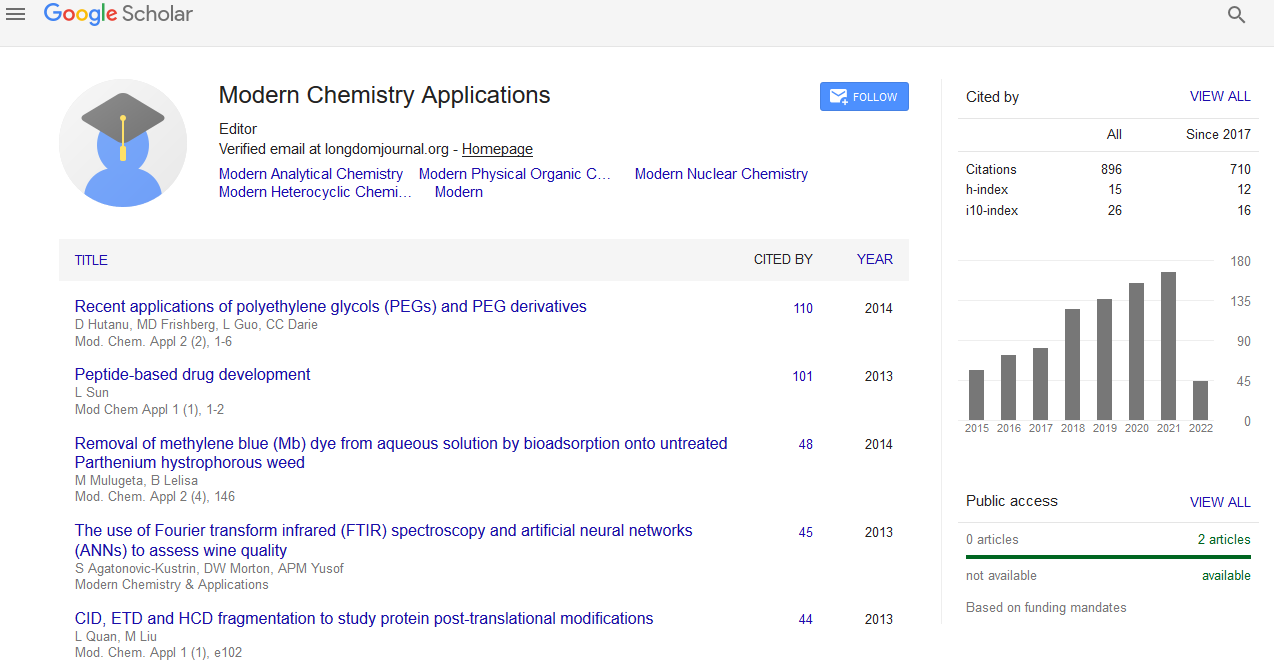Indexed In
- Open J Gate
- JournalTOCs
- RefSeek
- Hamdard University
- EBSCO A-Z
- OCLC- WorldCat
- Scholarsteer
- Publons
- Geneva Foundation for Medical Education and Research
- Google Scholar
Useful Links
Share This Page
Journal Flyer

Open Access Journals
- Agri and Aquaculture
- Biochemistry
- Bioinformatics & Systems Biology
- Business & Management
- Chemistry
- Clinical Sciences
- Engineering
- Food & Nutrition
- General Science
- Genetics & Molecular Biology
- Immunology & Microbiology
- Medical Sciences
- Neuroscience & Psychology
- Nursing & Health Care
- Pharmaceutical Sciences
Fluorescent derivatives of the amyloid ligand Congo red for the detection of Aò and Tau aggregates
5th Global Chemistry Congress
September 04-06, 2017 | London, UK
Jun Zhang
Linköping University, Sweden
Posters & Accepted Abstracts: Mod Chem Appl
Abstract:
Statement of the Problem: Alzheimer�??s disease (AD) is the most common neurodegenerative disorder of the brain and a leading cause of dementia. Aβ plaques consisting of Aβ peptides and Neurofibrillary Tangles (NFTs) consisting of hyperphosphorylated Tau has been recognized as the main two pathological hallmarks of AD. Investigation of Congo red led to the discovery of bisstyrylbenzenes as a class of compounds with strong Aβ plaque binding properties. Methodology & Theoretical Orientation: Starting from the amyloid ligand X-34, Aβ-fibril and Tau fibril binding affinities and specificities for the four fluorescent derivatives of X-34 were determined by means of fluorescence titrations with Aβ1-42 and Tau fibrils, respectively and a fluorescence assay using human AD brain sections. Findings: The five ligands can bind to Aβ1-42 and Tau fibrils with augmented intensities, respectively, but with very weak fluorescence changes in the presence of Aβ1-42 oligomer and monomer. Benzene and naphthalene derivatives upon binding to Aβ1-42 fibrils showed significantly increased quantum yields (QY). The thiophene derivative in buffer displayed high QY compared with the other probes, while quinoxaline and benzo[c][1,2,5]thiadiazole derivatives showed very low QY in the absence/presence of Aβ1-42 fibrils. The two pathological hallmarks, Aβ plaques and NFTs, could be readily identified due to bright fluorescence especially quinoxaline derivative, specifically stain Aβ plaques. Conclusion & Significance: The central benzene motif of X-34 can be replaced with other heterocyclic moieties without reducing the ligands�?? selectivity. However, the quinoxaline derivative can selectively detect Aβ plaques and not NFTs. We foresee that these ligands will be useful candidate markers for monitoring the formation and progression of a variety of diseaseassociated protein aggregates.
Biography :
Jun Zhang has his expertise in designing and synthesizing small fluorescent ligands for the identification of protein aggregates, the common pathological hallmark of many neurodegenerative diseases such as Alzheimer’s and Parkinson’s disease (AD and PD). These novel ligands will expand the tool box of fluorescent ligands for in vitro monitoring of amyloid fibril formation and in vivo monitoring of progression and deposition of various disease-associate proteins.


